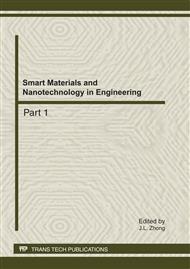p.370
p.375
p.381
p.387
p.393
p.399
p.405
p.411
p.417
Effects of Buthus martensii Karsch Venom on Cell Proliferation and Cytotoxicity in Hela Cells
Abstract:
This paper focuses on the effect of the venom of the scorpion Buthus martensii on the proliferation of human cervical carcinoma Hela cell line and the related molecular mechanism. MTT test showed that the scorpion venom inhibited proliferation of Hela cells in time-dependent and concentration-dependent manner with 50% inhibitory concentration (IC50) of 34.5 μg/mL(48 h). By using flow cytometry, it was found that the scorpion venom could induce apoptosis and necrosis in Hela cells. RT-PCR and Western blot indicated there were obviously up-regulated in the expressions of p21 protein but the expression of p21 mRNA showed no significant difference in the Hela cell by the scorpion venom. These results suggest that the possible mechanism of the scorpion venom is to activate the expressions of p21 protein and to cause Hela cell apoptosis.
Info:
Periodical:
Pages:
393-398
Citation:
Online since:
September 2011
Authors:
Keywords:
Price:
Сopyright:
© 2012 Trans Tech Publications Ltd. All Rights Reserved
Share:
Citation:


